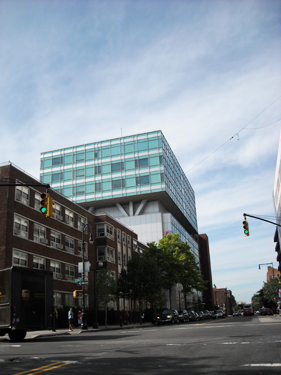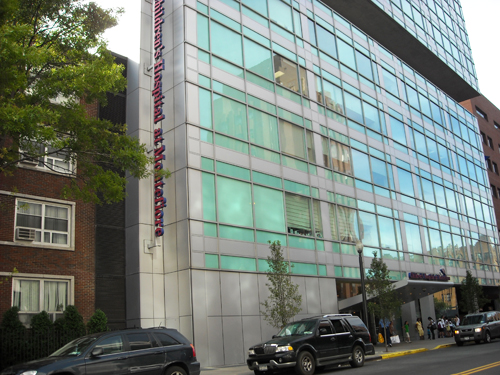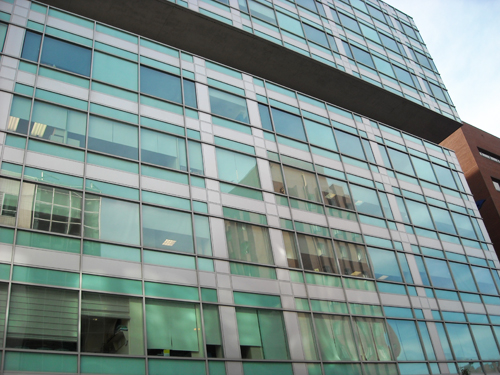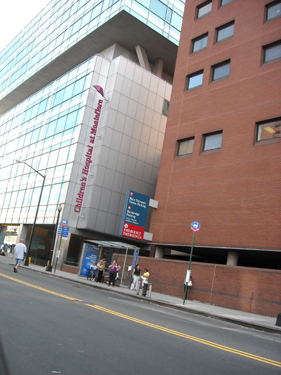Children’s Hospital at Montefiore
3415 Bainbridge Avenue (at Gun Hill Road)
SLCE, architects; Rockwell Group, interiors
2001
“You are here” reads the label on a striking glass-mosaic mural of the galaxy, pointing to the site of our solar system. More precisely, where you are is just inside the entrance of the Bronx’s first pediatric hospital, the 106-bed Children’s Hospital at Montefiore (CHAM). Its lobby is organized around a central well, with peripheral balconies and a curved, bridge-like ramp providing views to the level below. At intervals, the space is furnished with enigmatic exhibits. In addition to the galactic mural, there is (a) a functioning sealed biosphere; (b) an illuminated relief of the Moon’s surface; (c) a detailed satellite view of the Bronx; (d) a spherical bronze pendulum swinging from the ceiling; (e) a global hemisphere centered on New York, over which the pendulum sweeps; (e) a terrazzo floor depicting a series of objects from the very small (molecules) to the very large (the galaxy again), with two children midway.
Kids are predictably diverted by these eccentric displays. But their parents will still want to know what it all has to do with CHAM, whose world-class medical services—available to every Bronx family, however poor--have brought them to Bainbridge Avenue.
To decipher the lobby, they will need to know a little about its creators. Opened in 2001, the hospital was the brainchild of Dr. Irwin Redlener, director of the Children’s Health Fund, a pediatrician nationally known for his fierce efforts to bring health care and an appetite for a better life to deprived children. Redlener wanted a family-oriented, information-rich hospital, both reassuring and instructive, where parents could stay close to their child while learning more about his illness and its treatment. To feed the child’s own native curiosity, Redlener asked the Carl Sagan Foundation to develop a “Discovery Center” at the hospital, based on the teachings of scientific popularizer and public sage Sagan, who had been a personal friend. Interactive play stations, bedside customized computers, and pervasive imagery from all the realms of nature converge to “ignite” the patient’s imagination and infuse Sagan’s hopeful philosophy of cosmic interrelatedness: “We are all star stuff.”
The third, most unlikely partner in the project was designer/architect David Rockwell, celebrated contriver of jaw-dropping “themed” environments for fashionable restaurants and casinos, upscale stores and ballparks. His job was nothing less than replacing the traditional hospital stay with an entirely different experience. Strongly related to theatre, Rockwell’s designs typically provide not only “scenery”—an enveloping environment—but also the spatial and decorative cues to an unfolding dramatic story. At CHAM, he wove Redlener and Sagan’s ideas into a “plot”: the patient would be “an explorer on a voyage to knowledge and health.”
As the first declaration of an alternate world, the hospital’s lobby, like the vestibules at many of Rockwell’s sites, is especially important. It is the threshold of the adventure. Its flying ramp is almost literally a gangway. (One of the designer’s ideas was to equip each new patient with a gadget-filled “Explorer’s Kit.”) The lobby’s peculiar exhibits locate the young voyager on overlapping scientific maps. “You are here” -—at the edge of a galaxy, in a biosphere, beneath the Moon, in the Bronx, on a turning globe; larger than the microbe, smaller than the Empire State Building.
Rockwell has pursued his theme throughout CHAM’s seven floors of pediatric services, each of which has a quotation from Sagan and a wall-sized artwork in its elevator lobby. The patient’s window shades are even imprinted with views of the Bronx evolving from the Triassic to the present. But thankfully, Rockwell has not surrendered completely to Sagan’s scientific enthusiasm. Some of the best design at CHAM is in details that respond instead to Redlener’s empathy: friendly ornamented ceiling-tiles to be seen from a Gurney, for instance, or built-in couches for weary parents.
Looking around the lobby once more as you leave, you might want to consider its centerpiece, a sculptural version of the “Foucault Pendulum.” This is a scientific device which demonstrates the rotation of the Earth by apparently changing the direction of its own ponderous swing in the course of twenty-four hours, very gradually working its way through 360 degrees. In his work Suspended Mind, Tom Otterness has shaped the pendulum as a giant inverted child’s head with a fixed grin, centered on the Bronx but sweeping over the face of the globe, while tiny bronze citizens look on in apprehension and delight—an apt representation of the adventure at CHAM.
David Bady
Photographs:
Lehman College Art Gallery



